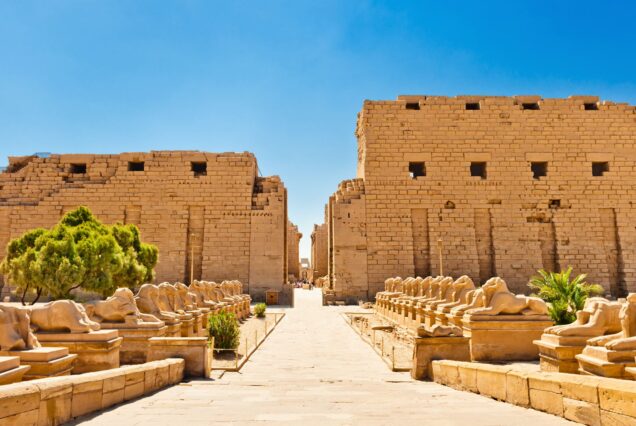Luxor City Break: An Enriching 2-Day Tour of Ancient Egypt
Duration
5 Hours
Max People
6
Min Age
1+
Pickup
Hotel
Luxor City Break: An Enriching 2-Day Tour of Ancient Egypt
Luxor, often referred to as the world’s greatest open-air museum, is home to some of the most significant archaeological sites in Egypt. With its breathtaking temples and ancient tombs, this city offers an unparalleled glimpse into the grandeur of Egyptian civilization. This comprehensive 2-day tour promises to immerse travelers in the rich history and cultural heritage of this remarkable city.
Culinary Experience: Savoring Egyptian Cuisine
Traditional Egyptian Dishes to Try
A trip to Luxor wouldn’t be complete without indulging in its culinary delights. We recommend tasting local favorites such as Koshari, a hearty blend of rice, lentils, and pasta topped with a zesty tomato sauce, or Ful Medames, a savory fava bean dish seasoned with garlic and lemon. For dessert, don’t miss out on Basbousa, a sweet semolina cake soaked in syrup, perfect for satisfying your sweet tooth.
Tips for Travelers
Best Time to Visit
The ideal time to explore Luxor is during the cooler months, from October to April, when temperatures are more comfortable for sightseeing.
Dress Code and Cultural Etiquette
When visiting temples and historical sites, it’s advisable to wear modest clothing that covers shoulders and knees. Respecting local customs enhances the experience and demonstrates cultural sensitivity.
[trustindex no-registration=tripadvisor]
Included/Excluded
- Specialized bilingual guide
- Private Transport
- All service charges and taxes .
- bottled mineral waterduring the tour
- Visa to Egypt
- Entry Fees
- Accommodation
- Airport Transfers
- Domestic Flight ( Cairo- Luxor / Cairo)
- The above Prices are not valid during the Peak Periods (New Year - Christmas - Easter)
- Meals ,Food, Drinks, Snacks
- any optional tours,Personal Expenses and Souvenirs
Tour Plan
Our journey begins at the Valley of the Kings, the final resting place of numerous pharaohs, including the legendary Tutankhamun. Visitors can explore the intricately decorated tombs that reflect the grandeur of ancient Egyptian beliefs about the afterlife. Notable tombs such as those of Ramses II and Seti I showcase stunning hieroglyphics and murals, offering insights into their reigns and the mythology surrounding them.
Temple of Hatshepsut: A Monument to a Female Pharaoh
Next, we visit the Temple of Hatshepsut, a striking mortuary temple dedicated to one of Egypt’s most iconic female rulers. The temple’s unique terraced design and stunning location against the backdrop of the cliffs create a mesmerizing sight. Here, we can learn about Hatshepsut’s remarkable reign and her efforts to establish trade networks and monumental construction projects.
Colossi of Memnon: Guardians of the Past
Our first day concludes with a visit to the Colossi of Memnon, two massive stone statues that once guarded the entrance to Amenhotep III’s mortuary temple. These monumental figures stand as silent sentinels, evoking the grandeur of ancient times. Travelers can capture stunning photographs and reflect on the enigmatic history of these colossal statues.
On the second day, we head to the Karnak Temple, the largest religious complex ever constructed. Covering over 200 acres, this vast site consists of a series of temples, chapels, and pylons dedicated primarily to the god Amun. The Great Hypostyle Hall, with its 134 towering columns, leaves visitors in awe of its scale and architectural brilliance. Guided tours often delve into the complex’s historical significance, including the rituals that took place here.
Luxor Temple: A Testament to Ancient Architecture
Following our exploration of Karnak, we visit Luxor Temple, an architectural masterpiece that served as a center for worship and an important site for the Opet Festival. The temple’s colossal statues and obelisks, particularly the impressive pair of seated statues of Ramses II, symbolize the power of the pharaohs. Strolling through the temple at dusk provides a magical atmosphere, with the illuminated structures creating an ethereal ambiance.
Tour Map
Global Discount
| Min - Max (Persons) | Adult Price | Child Price |
|---|---|---|
| 10 - 20 | $25,00 | $0,00 |
Special Time
| Start Date | End Date | Adult Price | Child Price | Discount |
|---|---|---|---|---|
| 01-06-2024 | 30-08-2024 | $25,00 | $20,00 | View Discount |














Leave a Reply